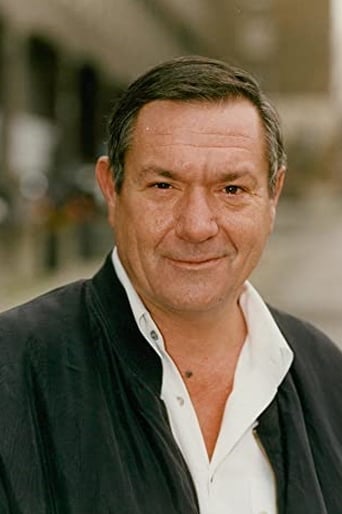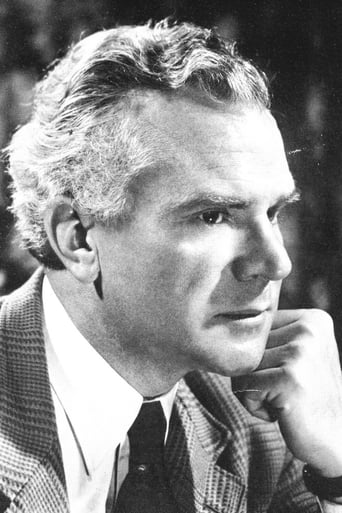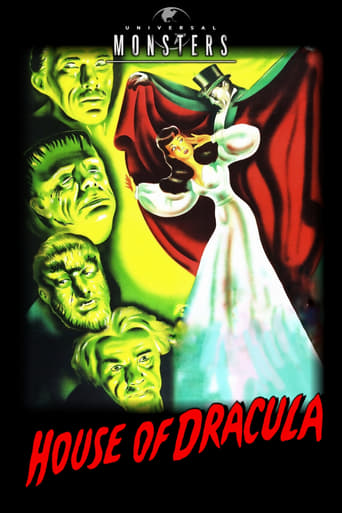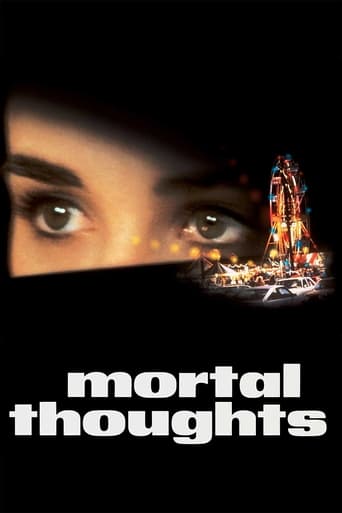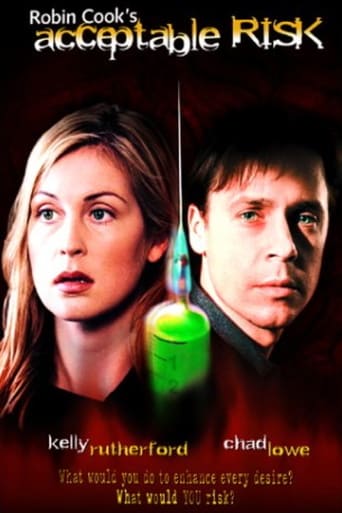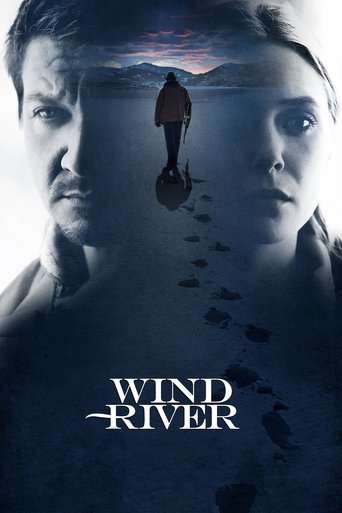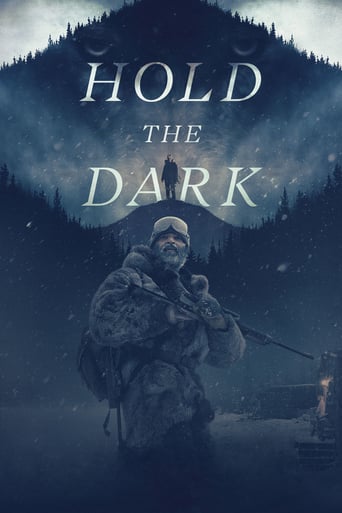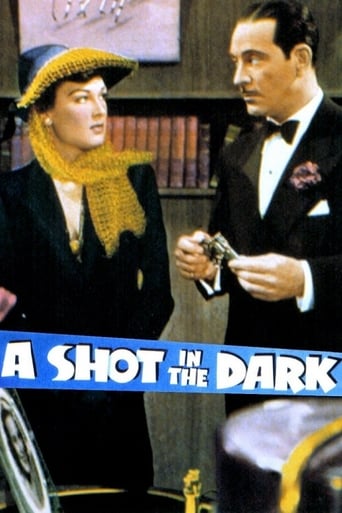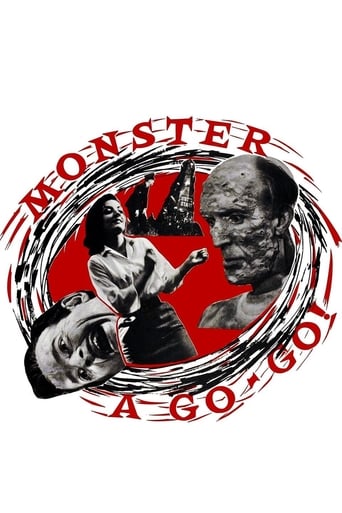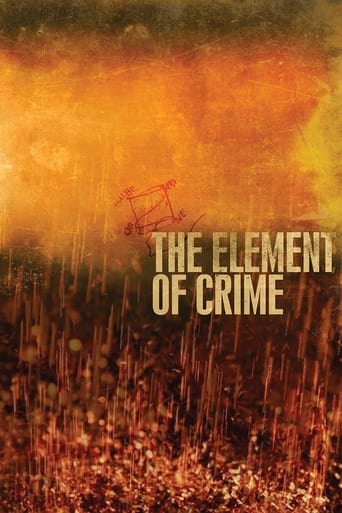
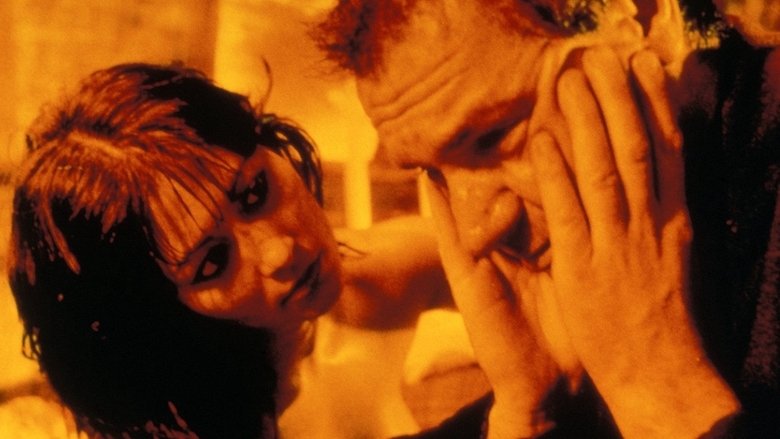
The Element of Crime (1987)
Fisher, an ex-detective, decides to take one final case when a mysterious serial killer claims the lives of several young girls. Fisher, unable to find the culprit, turns to Osbourne, a writer who was once respected for his contributions to the field of criminology. Fisher begins to use Osbourne's technique, which involves empathizing with serial killers; however, as the detective becomes increasingly engrossed in this method, things take a disturbing turn.
Watch Trailer
Cast
Similar titles
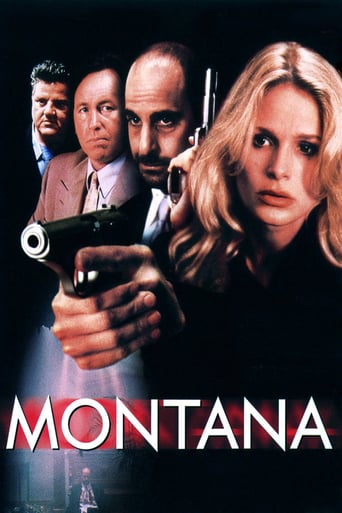
Reviews
Best movie of this year hands down!
As Good As It Gets
A movie that not only functions as a solid scarefest but a razor-sharp satire.
The storyline feels a little thin and moth-eaten in parts but this sequel is plenty of fun.
Captivating, Mesmerizing, Hypnotic, Saturating Visuals Highlight this Debut Film from Director Von Trier. It's a Slow-Burn, Slow-Walk through an Ex-Cop's Hypnosis Projection to Solve a Serial Child-Murder Spree. The Lotto Girls Murder Case.Drawing from the Fringes of Cinema's Auteurs, LVT Crafts a Modern Dystonia Film-Noir that Slogs through the Earth's Elements (Water-Earth-Air-Fire) as the Sights Unfold and are Overlaid on the Viewer's Perception of Things and it's all Murky, Muddy, Smoky, and Smoldering with Rain, Ashes, and Ambiguity.Nothing is Clear. After All, it's a Hypnotic State as Fisher (Michael Elphick), the Detective, Voice Overs Occasionally to Relay what the Experience Uncovers and it's all Very Unpleasant.The Movie is Stunningly Framed, with an Enormous Amount of Attention to Detail, and the Cinematography and Lighting are Breathtaking. It Truly is Artistic. The Narrative is not that Engaging and the Dialog only Occasionally Ignites. The Crime Story Itself seems Anti-Climatic when it is Resolved.Overall, it is Experimental Movie-Making from a Rookie Director and Divides Audiences to Extremes. Worth a Watch for the Avant-garde and Cult Movie Fans.Mainstream Audience Acceptance will Not be Forthcoming. But for those that Prefer Their Film Going Experience to be on the Edge. Look No Further than the Filmography of Lars Von Trier's.
Von Trier has created some masterpieces, but also some beautiful and very flawed films. Still, as far as his style The Element of Crime is the first of his without the Dogme shaky-cam style. Let's get this out of the way. It reminds me a lot of Lynch's Eraserhead and Aronofsky's Pi in how technically brilliant, but also how surreal and how cold they are. But unlike those, this one really tested my patience at times. It has some brilliant sound design, and some really amazing lighting and cinematography. There's quite a few shots here that will linger in the mind, but as a whole the plot is quite messy and not very comprehendable. Some could say it fits as a Lynch film in a way, but I found this to be much more of a mixed bag than many of Lynch's works. Overall, as a journey through avant-garde territory with really surreal, stylized, and just unsettling and odd moments, it's recommended, but as a whole you may feel yourself checking the clock one too many times.
"Do you believe me? I'm in the middle of Europe screwing a Volkswagen 1200." A brilliantly esoteric pseudo-murder-mystery, The Element of Crime brings to mind the work of Paul Auster, stories like Ghosts and City of Glass. The fact that the entire film is communicated through the hypnosis-induced memories of a former detective leads to a breathtaking heightened reality that makes the film's dreamy visual sensibility irresistible. I don't know if it's thanks to Von Trier or Criterion (who deigned this movie one of the first entries into their Collection), but the print is GORGEOUS, and is damn near impossibly clean for a film made in 1984. Amadeus didn't look this good the day it came out.Like Auster's masterpieces, the film is technically about a murder, a detective named Fisher (Michael Elphick) returning to Europe from Cairo after a thirteen-year absence, come back to investigate a child killer named Harry Grey, as informed by his mentor Osborne (Esmond Knight), a mysterious prostitute named Kim (Me Me Lai) and antagonistic Chief of Police Kramer (Jerold Wells). He is telling all this from memory to a therapist (Ahmed El Shenawi), and the atmosphere is in kind.The film is completely shot in a burnt-umber tint, with occasional hints of blue coming through for minor things like police lights, and I can't be exact, but I would be willing to bet that the entire film is shot at nighttime, and at least 90% of it is during a severe rainstorm (Dark City, eat your heart out). It really is the doom-and-gloom special, and it's perfect for maintaining the mood the film is looking to put forth. Like Rose Hobart, it's the combination that makes all the difference. Alone, any of these elements (of crime?! No.) could have been comfortable, even soothing, but in tandem, they're haunting and unsettling, and kept me on the edge even at times when nothing of substance was occurring on screen.This is not to say that a lot of tangible things DO occur on screen. Anyone coming into The Element of Crime looking for a straightforward detective movie, where he follows the clues and solves the crime, is going to be sorely disappointed. This is why I'm glad I had read City of Glass previously. I realized straight away that this wasn't going to be ordinary or obvious. For Fisher, what originally begins as an investigation very quickly spirals down into a series of bizarre encounters and off-the-wall experiences, and he gets so deep into his desperate search and into his own psyche that he begins to lose his identity, and damn near his capacity for rational thought, and the results are spellbinding.Of course, considering the director, I should have realized substantially sooner than the start of the film that this wasn't going to be Agatha Christie ordinary. Ol' Lars doesn't do ordinary. Hell, even his most 'commercial' film (his office comedy The Boss of It All) is a long way from starring Will Smith, and his greatest films, like Dogville or Zentropa, are "off" just enough to be unique. I think this is the thing that attracts people who might not be aligned with Von Trier's world view, his cinematic approach, might find themselves lost in an area that they aren't comfortable with. For all you crazy kids who think you might be, give Von Trier's debut film a whirl. Be warned, though: It just might whirl you back.{Grade: 8.5/10 (B+) / #11 (of 26) of 1984}
Beginning a trilogy of films dealing specifically with the decline of post-war Europe, this extraordinary, heavily referential, psychological thriller would be the first cinematic outing from acclaimed Danish filmmaker Lars von Trier. Like all of the director's early works, the story is convoluted, and works best as an example of cinematic dream-logic, unfolding in an undisclosed European state, where day and night no longer exist, rain seems to be falling almost constantly and the only colour we see is a thick yellow sepia that is only occasionally pierced by jarring shafts of neon light. The story then builds on ideas of faith, redemption, love and mental anguish, familiar in symbolic rigour to the works of Ingmar Bergman - but with a fragmented composition and style more akin to the framing of Andrei Tarkovsky, or the industrial surrealism of David Lynch.From the opening images of a donkey basking in the hot sands of a Cairo desert (a metaphor for the central character and a reference in it's self to the Tarkovsky classic Andrei Rublev), to the waterlogged depiction of Europe, filled with burnt-out cars, decaying animal carcasses & lost children, The Element of Crime creates a world so murky, so damaged and so lost within the abyss, that it expressionistically conveys the sense of detachment and pain felt by the central protagonist, Fisher. Fisher is a washed up former detective, who after living in Cairo for a number of years, returns to his native Europe to help his mentor Osborn with a murder investigation. In the first scene - which takes place two months after the events of the main story - an unseen Fisher sits in a psychiatrist's office conversing with the doctor who promises to help him find the root to his problems. Here, von Trier is able to utilise one of his favourite narrative devises, hypnosis... as he blends together the character's psyche with the action in the film. From this point on, the entire film takes place from Fisher's point-of-view, his voice-over only rarely broken by the psychiatrist, who pops up to keep the story on track.In the lead role, the great Michael Elphick acquits himself admirably, though his role in the film (like all of the actors) is little more than a marionette to von Trier's demented puppet master (although, to be fair, with his rugged appearance and monotonous delivery of lines, he does successfully ease himself into the role of the gumshoe perfectly, brining to mind some of the genre's best-loved anti-heroes... for example, Philip Marlow from the Singing Detective fantasy sequences or Lemmy Caution from Godard's similarly dystopic masterpiece Alphaville). However, what is amazing about The Element of Crime far beyond acting, is von Trier's way of breaking down the genre - not content with producing a carbon copy of classic thrillers run through with art-house dramatics, he sets about subverting and destroying both design and ideology - like a schoolboy scribbling graffiti in a textbook, the result is jarring, criminally audacious and completely astounding. Here, white linen suits replace hats and trench coats, reflections are used in both mirrors and clouded puddles to heighten the idea of fragmented personalities and schizophrenia, just as the use of sepia printing suggests the murkiness to Fisher's subconscious. The neon lights that breaks the composition of the frame, usually from a police light or a flickering television set, act as beacons to the hidden depths of Fisher's mind - whenever some moment of remembrance occurs, a light will often be present to signify to the audience the usual emotion connected with the colour (blue - recollection, green - sickness, red - anger etc) - just as the use of double exposures and heavy sound-design build the flash-backs, dreamscapes and memories within memories.The other actors in the film are used like puppets to an even greater extent. Whereas Fisher is here for our benefit, they are there for his. Osborn for example, who is played with ailing charm by the great British actor Esmonde Knight (fans of Michael Powell will be familiar), gives the information that will lead both plot and dénouement, whilst the casting of Me-Me Lia as Kim again subverts the usual preconceptions of the femme-fatale by being a teasing, manipulative prostitute - with dark Asian looks that undercut the genre's usual 'wasp-ish' stereotypes. Her character presents both complications and a love interest/sidekick for Fisher, as well as other more meaningful purposes as the film moves towards the ambiguous climax - suggesting a state of abandonment and complete mental breakdown, as the shocking twists begin to pile up. Surpassing both A Clockwork Orange and 1984 in it's subversive attack and artistic vision, The Element of Crime presents to us a definitively dark and unrelenting image of Europe, in which chaos has overthrown order, analytical approaches to police work have been replaced by Gestapo bully tactics, and the chance of a changing season is nothing but a mere pipe dream.This is a staggering and inventive mish-mash of ideas and stylistic references that present us with an alluring potion of haunting images, heart-stopping bursts of violence, elaborate philosophies, unashamed pretension and a plot that writhes right the way through to its unflinching climax... which, coming from one of contemporary cinema's most important auteurs, should not be missed. Those familiar with his later works, such as Breaking the Waves, The Idiots and Dogville, may be surprised by von Trier's bold grasp of staggering cinematic technique and intelligent understanding of the conventions of post-war film-noir... something even more apparent in his later masterpiece, Europa.
